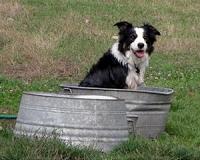| . |  |
. |
Philadelphia PA (SPX) Feb 03, 2010 Biologists at the University of Pennsylvania studying the processes of evolution appear to have resolved a longstanding conundrum: How can organisms be robust against the effects of mutations yet simultaneously adaptable when the environment changes? The short answer, according to University of Pennsylvania biologist Joshua B. Plotkin, is that these two requirements are often not contradictory and that an optimal level of robustness maintains the phenotype in one environment but also allows adaptation to environmental change. Using an original mathematical model, researchers demonstrated that mutational robustness can either impede or facilitate adaptation depending on the population size, the mutation rate and a measure of the reproductive capabilities of a variety of genotypes, called the fitness landscape. The results provide a quantitative understanding of the relationship between robustness and evolvability, clarify a significant ambiguity in evolutionary theory and should help illuminate outstanding problems in molecular and experimental evolution, evolutionary development and protein engineering. The key insight behind this counterintuitive finding is that neutral mutations can set the stage for future, beneficial adaptation. Specifically, researchers found that more robust populations are faster to adapt when the effects of neutral and beneficial mutations are intertwined. Neutral mutations do not impact the phenotype, but they may influence the effects of subsequent mutations in beneficial ways. To quantify this idea, the study's authors created a general mathematical model of gene interactions and their effects on an organism's phenotype. When the researchers analyzed the model, they found that populations with intermediate levels of robustness were the fastest to adapt to novel environments. These adaptable populations balanced genetic diversity and the rate of phenotypically penetrant mutations to optimally explore the range of possible phenotypes. The researchers also used computer simulations to check their result under many alternative versions of the basic model. Although there is not yet sufficient data to test these theoretical results in nature, the authors simulated the evolution of RNA molecules, confirming that their theoretical results could predict the rate of adaptation. "Biologists have long wondered how can organisms be robust and also adaptable," said Plotkin, assistant professor in the Department of Biology in Penn's School of Arts and Sciences. "After all, robust things don't change, so how can an organism be robust against mutation but also be prepared to adapt when the environment changes? It has always seemed like an enigma." Robustness is a measure of how genetic mutations affect an organism's phenotype, or the set of physical traits, behaviors and features shaped by evolution. It would seem to be the opposite of evolvability, preventing a population from adapting to environmental change. In a robust individual, mutations are mostly neutral, meaning they have little effect on the phenotype. Since adaptation requires mutations with beneficial phenotypic effects, robust populations seem to be at a disadvantage. The Penn-led research team has demonstrated that this intuition is sometimes wrong. The study, appearing in the current issue of the journal Nature, was conducted by Jeremy A. Draghi, Todd L. Parsons and Plotkin from Penn's Department of Biology and Gunter P. Wagner of the Department of Ecology and Evolutionary Biology at Yale University.
Share This Article With Planet Earth
Related Links University of Pennsylvania Darwin Today At TerraDaily.com
 Survival Of The Cutest Proves Darwin Right
Survival Of The Cutest Proves Darwin RightManchester, UK (SPX) Feb 02, 2010 Domestic dogs have followed their own evolutionary path, twisting Darwin's directive 'survival of the fittest' to their own needs - and have proved him right in the process, according to a new study by biologists Chris Klingenberg, of The University of Manchester and Abby Drake, of the College of the Holy Cross in the US. The study, published in The American Naturalist, compared the skull ... read more |
|
| The content herein, unless otherwise known to be public domain, are Copyright 1995-2010 - SpaceDaily. AFP and UPI Wire Stories are copyright Agence France-Presse and United Press International. ESA Portal Reports are copyright European Space Agency. All NASA sourced material is public domain. Additional copyrights may apply in whole or part to other bona fide parties. Advertising does not imply endorsement,agreement or approval of any opinions, statements or information provided by SpaceDaily on any Web page published or hosted by SpaceDaily. Privacy Statement |